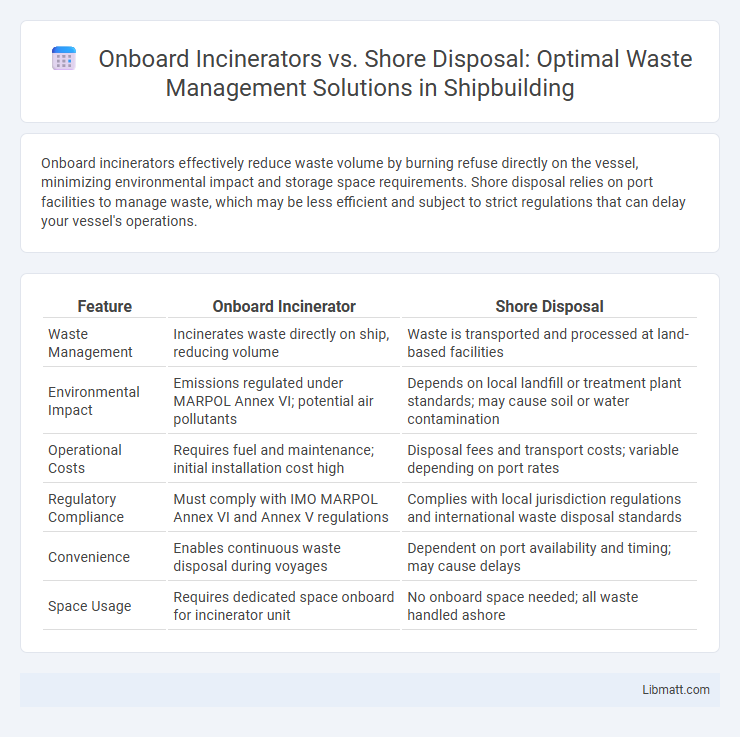Onboard incinerators effectively reduce waste volume by burning refuse directly on the vessel, minimizing environmental impact and storage space requirements. Shore disposal relies on port facilities to manage waste, which may be less efficient and subject to strict regulations that can delay your vessel's operations.
Table of Comparison
| Feature | Onboard Incinerator | Shore Disposal |
|---|---|---|
| Waste Management | Incinerates waste directly on ship, reducing volume | Waste is transported and processed at land-based facilities |
| Environmental Impact | Emissions regulated under MARPOL Annex VI; potential air pollutants | Depends on local landfill or treatment plant standards; may cause soil or water contamination |
| Operational Costs | Requires fuel and maintenance; initial installation cost high | Disposal fees and transport costs; variable depending on port rates |
| Regulatory Compliance | Must comply with IMO MARPOL Annex VI and Annex V regulations | Complies with local jurisdiction regulations and international waste disposal standards |
| Convenience | Enables continuous waste disposal during voyages | Dependent on port availability and timing; may cause delays |
| Space Usage | Requires dedicated space onboard for incinerator unit | No onboard space needed; all waste handled ashore |
Introduction to Maritime Waste Management
Maritime waste management requires efficient disposal methods to minimize environmental impact and comply with international regulations such as MARPOL Annex V. Onboard incinerators offer immediate waste reduction by burning garbage at sea, significantly decreasing landfill dependency and reducing storage space onboard vessels. Shore disposal, while reliant on port facilities, ensures waste is treated in controlled environments, preventing marine pollution but often involves logistical challenges and higher operational costs.
Overview of Onboard Incinerators
Onboard incinerators are specialized waste treatment systems installed on ships to combust solid and liquid wastes generated during voyages, reducing volume and environmental impact before disposal. These systems comply with MARPOL Annex VI regulations, ensuring emissions meet international standards while minimizing reliance on port reception facilities. Efficient onboard incineration reduces the logistical challenges and costs associated with shore disposal, especially for long-duration voyages or ships operating in remote areas.
Principles of Shore-based Waste Disposal
Shore-based waste disposal operates on principles of centralized treatment and strict regulatory compliance to minimize environmental impact, involving methods such as landfilling, recycling, and advanced waste treatment facilities. These systems emphasize segregating waste types and ensuring proper containment to prevent leachate and air pollution, supported by continuous monitoring and adherence to local and international environmental standards. Effective shore disposal reduces marine pollution risks and promotes sustainable waste management in coastal and port areas.
Environmental Impact Comparison
Onboard incinerators reduce waste volume and minimize the risk of marine pollution by combusting waste at high temperatures, converting it into less harmful ash and gases. Shore disposal often leads to increased environmental risks due to potential contamination of soil and groundwater from improperly managed waste facilities, especially in sensitive coastal areas. Your choice between onboard incineration and shore disposal significantly influences the preservation of marine ecosystems and compliance with international environmental regulations like MARPOL Annex VI.
Regulatory Requirements and Compliance
Onboard incinerators must comply with the International Maritime Organization's MARPOL Annex VI regulations, which limit emissions of harmful pollutants such as dioxins, furans, and particulate matter. Shore disposal requires adherence to local environmental laws and waste management standards, often involving strict permitting and monitoring to prevent soil and water contamination. Understanding these regulatory requirements ensures your waste management practices remain compliant and environmentally responsible.
Cost Analysis: Installation vs. Operational Expenses
Onboard incinerators require a substantial initial investment for installation, including equipment purchase, integration with ship systems, and regulatory compliance certification, often exceeding $100,000. Operational expenses encompass fuel consumption, maintenance, ash handling, and skilled personnel, typically amounting to $20,000-$50,000 annually. Shore disposal offers lower upfront costs but incurs ongoing fees for waste transport and landfill tipping, which can surpass onboard operational costs over long durations depending on port fees and travel frequency.
Efficiency and Waste Handling Capacity
Onboard incinerators provide efficient waste reduction by combusting solid and liquid waste directly on the vessel, significantly decreasing volume and weight, which reduces storage space requirements onboard. These systems can handle large waste volumes continuously, making them ideal for long voyages with limited disposal options. Shore disposal, while dependent on port facilities, offers higher overall processing capacity for diverse waste types, but requires temporary storage onboard and can be limited by port regulations and availability.
Safety Considerations and Risks
Onboard incinerators reduce the volume of waste but pose safety risks such as fire hazards, toxic emissions, and equipment malfunctions that require strict maintenance and monitoring protocols. Shore disposal eliminates onboard combustion risks but may introduce health and environmental concerns if waste is not properly handled or processed at facilities compliant with international maritime regulations. Ensuring crew safety involves balancing onboard control with compliance to shore-based waste management standards to minimize toxic exposure and accident potential.
Technological Advancements in Waste Treatment
Onboard incinerators have evolved with advanced combustion technology, reducing emissions and improving energy efficiency compared to earlier models. Shore disposal facilities now incorporate cutting-edge waste sorting and recycling systems, enhancing environmental compliance and resource recovery. Both approaches increasingly integrate digital monitoring systems for optimized waste management and regulatory adherence.
Choosing the Optimal Solution for Vessels
Onboard incinerators effectively reduce waste volume and comply with MARPOL Annex VI regulations, providing environmental benefits by minimizing pollutants directly on the vessel. Shore disposal offers more comprehensive waste management options, including recycling and treatment facilities, but involves logistical challenges and potential port fees that increase operational costs. Evaluating your vessel's operational routes, waste types, and compliance requirements ensures the optimal solution supports sustainable and cost-efficient waste management.
Onboard incinerator vs shore disposal Infographic

 libmatt.com
libmatt.com